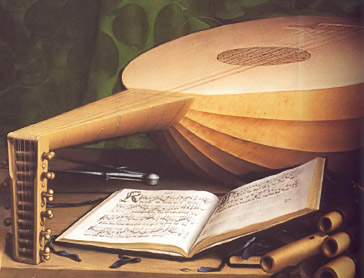
LUTE CAMERATA
LEVEL ONE
home
Level one: A good sound. Know what they knew, and practice. Tuning. Simple pieces, basic technique. Beginning notation. Throw away your solo CDs.
Level two: books of songs; simple scores, two clefs. Jack & Joan. Simple pieces and songs from both Tab and keyboard notation. The grand rotation.
Level three: basic singing, basic sight-reading; intermediate musicianship.
Level Four: The art of accompanying. Ensemble skills. Medium to high difficulty part songs.
Level five: the great solos and real renaissance ornaments; complex scores, clefs. Different Tab versions, singing from TAB. Arranging. The art of orchestra playing. Advanced rhythms such as late 14th century music and pieces by Tye and Baldwin.
Level Six: True professional, thorough knowledge of the middle ages, renaissance and baroque. All clefs. Al scores. All solos. All songs.
|
The paradigms of thought Level one is fairly easy--it is, after all, level one. Essentially, you will need to read a few books; study & memorize a few things. And practice everyday. After you do this, you will have a window into the past. First, you must make a perfect note on the lute, or a very good sound. In order to do this, you must hit both strings (start with the second course, then the third) with and easy and fluid motion. It is best to start with the soundboard facing the ceiling, then when the note is perfect, try again in normal position. Until you learn this simple skill, you cannot get better :( Anyone who wants a free lesson on how to do this need only ask. Practice: one perfect note (Then play four in a row.)
Tuning. Best to have your teacher show you :) Next, you must learn to sing the notes on the open strings of the lute. You must listen, then match the pitch with your voice.You must never use a tuning machine, by the way, or you will ruin your ear. If you must use a machine, set it to "tone only", so you must still liste, not look. When you do this simple act of playing, singing & listing you are developing essential music skills. You will need them, believe me. To memorize: A sonnet A lute song in any language, both words and notes A lute pavan & galliard pair To read, a book by Frances Yates Howard Brown To Learn: To Find any note on the lute: know your lute. You must know what all the notes are on the lute without having to make extensive calculations. One of the great dangers for students of the lute is listening to solo CDs. CDs present a completely warped view of reality due to the extensive editing and processing of the sound. Digital audio technolgy has now progressed to the point where anyone can can correct every aspect of the pitch, timing, performance and sound. By listening to this artificial sound, you will unconciously try to imitate something that is not real: this will invariably prevent you from improving. Instead, try youtube, bearing in mind that the top players can and do edit both the video and the sound on youtube as well. To sing the syllables of the hexachord, the absolute basis for music theory for the middle ages, renaissance & early baroque.
Imagine for a moment that you have been transported to a dinner party at the home of a well-to-do Elizabethan. removing your lute from its mylar case (with carbon fibre stitching) you feel prepared--unless the hexachord babel fish is on the blink. I'll begin with where I end , with Thomas Morley's Plain and Easy Introduction to Practical Music: (this is very important) "....But supper being ended and music books (according to the custom) being brought to the table, the mistress of the house presented me with a part earnestly requesting me to sing; but when, after many excuses, I protested unfeignedly that I could not, everyone begun to wonder; yea, some whispered to others demanding how I was brought up..." For the Elizabethans & the musicians of the renaissance, the notes of the hexachord were the symbols & language of music, a language both beautiful & universal. There were no lute or viol or harp or guitar or organ specialists who only read tablature: it would have been socially unacceptable. To understand tablature as it appeared to the women & men of the renaissance, we must understand the basic foundation of their education: free back & forth translation. The student would translate from English to Italian, or English to Latin, or Greek (and many other languages), and then reverse the translation and compare the results. After endless hours of practice, this simple exercise developed razor sharp mind--the eqivalent of DSP. They were well-versed. When the Elizabethans looked at tablature, they did not see a flat- picture-appendage locator, similar to twister, instead they saw a three- dimensional, full-color polyphonic web based on years of singing, musical training, and the ability to instantly translate shorthand For the Elizabethans, playing tablature without visualizing the polyphonic web would not only have been impossible, owing to their education, but equivalent to tracing a text instead of reading it. Now that you know that musical notation is required for dinner, proceed to page two. |